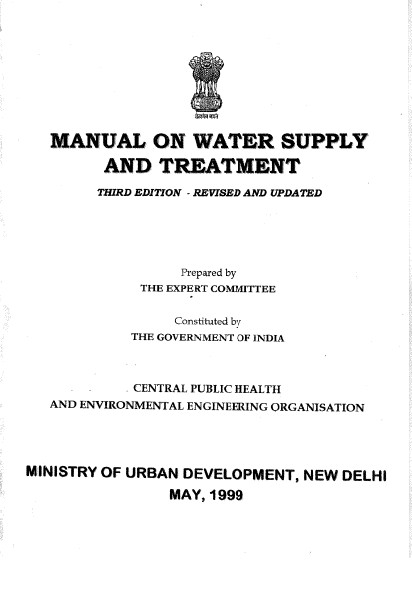Manual on Water Supply and Treatment
 |
manuel May 1999 ; 777 pages
Ed. MoUD - New Delhi - 3 édition
Téléchargeable sous format: PdF
Téléchargeable chez l'éditeur
Page de présentation d'un éditeur
Abstract:
A number of factors are involved in tackling the problem of provision of protected water supply to all communities at minimum cost and in the shortest possible time. Emphasis has to be laid on both the aspects of the system namely, planning and management, both technical and financial. At present, decisions, both at the policy level and the technical level are based on emperical considerations and divergent practices that are in vogue in the country as far as the designing of the system is concerned.
The manual aims at unification of these practices and attempts at inculcating a rationale to the policy and managerial decisions, apart from giving guidence to public health engineers in achieving the target of providing safe water to all communities economically and expeditiously.
The manual discusses principles such as planning, identification of the source of water supply, development and transmission, water treatment, distribution system, testing and other related administrative aspects and also explains the approach to deal with each problem in detail.
The manual has been revised from time to time and has taken into account the recent technical advances and trends in the development of protected water supply systems, some of the major changes and additions as highlighted in the following areas:
Groundwater extraction through radial wells
Measurement of flow
Minimum requirements for domestic, non-domestic, institutional, fire fighting and industrial needs
Minimum residual pressure and quality standards including virological aspects
Concept of unit operations
Chemical handling and feeding
Recent concepts of coagulation and flocculation
Advances in filtration
Operation and maintanance problems in various unit operations involved in water supply, from source development to the actual supply
Pumping stations and equipment
Hydraulic network analysis, direct design of networks and computer programming
Preventive maintenance including detection and prevention of wastage
Protection against pollution and freezing
Corrosion and its prevention
Water hammer problems
House service connections
Optimal designs of water treatment systems
Instrumentation and controls in water treatment plants
Financing and management
Legal aspects
Laboratory tests and proceedures with special reference to the classification of the water works laboratories
Contents:
The manual has been divided into the following chapters:
Introduction
Planning
Project report
Measurement of flow
Sources of supply
Transmission of water
Water treatment
Disinfection
Specific treatment processes
Distribution system
Pumping stations and machinery
Instrumentation and controls in water treatment plans
Operation and maintenance of waterworks
Water works management
Laboratory tests and proceedures
Computer aided optimal design of water treatment system
Financial management of water supply projects
Legal aspects
Pays concerné: |
Editeur/Diffuseur: |
|
MoUD
-
Ministry of Urban Development - New Delhi - Inde |
En cas de lien brisé, nous le mentionner à communication@pseau.org